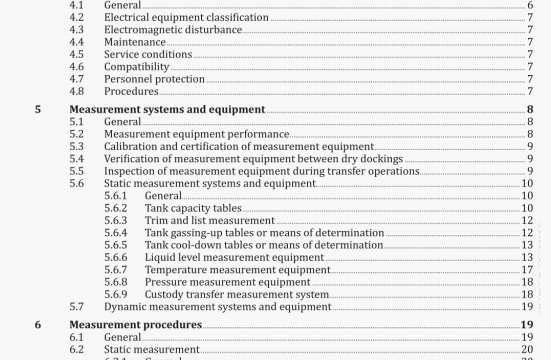ISO 10976 pdf download – Refrigerated light hydrocarbon fluids一Measurement of cargoes on board LNG carriers.
A multiple-spot automatic tank thermometer (ATT) (see 1L22) with an averaging function shall be used for temperature measurement. ISO 8310 may provide guidance for calibration and field verification. The equipment shall be designed to measure the low temperatures encountered in INC service as defined in EN 1160.
There should be a minimum of five temperature sensors in each tank and at least one temperature sensor shall he located above the maximum fill height so as to remain in the vapour space. Each temperature sensor shall be supported by a secondary sensor mounted adfacent to the primary temperature sensor. The All’ system shall read and provide individual temperatures for both liquid and vapour space and allow their averages to be determined. Smaller LNG carriers may have fewer temperature sensors; however. ICC Code requires a mInimum of three.
The lowest temperature sensor shall be located near the bottom of the tank so as to measure the temperature of the heel.
Sensors shall be positioned in such manner as not to directly expose them to spray from the cool- down nozzles.
5.6.8 Pressure measurement equipment
A pressure sensor is required at an appropriate position to measure the vapour space pressure. The pressure sensor shall be calibrated or verified to meet the requirements set forth in applicable API, ISO and relevant industry standards, as well as the requirements of the vessel’s flag administration and classification societies.
5.6.9 Custody transfer measurement system
5.6.9.1 The CrMS processes all of the on board INC carrier measurement information. It monitors and records the following Inputs:
a) level;
b) temperature;
c) pressure;
d) trim and list.
The CTMS performs numerous functions and calculations including
— averaging readings over time,
— filtering readings,
— applying corrections, i.e. thermal, trim, list, pressure.
— determining volumes using computer-based tank capacity tables, and
— generating custody transfer reports.
5.6.9.2 A CTMS shall incorporate at least the following calculations using the measurements of level, temperature and pressure and data from the tank capacity tables (for examples of tables, see Annexl):
a) level gauge correction for trim and list;
b) level gauge correction for vapour temperatures;
c) volumes, corrected for temperature where applicable.
5.7 Dynamic measurement systems and equipment
At the time of publication of this International Standard, technologies, such as Curious and ultrasonic flow meters, are available, but are not yet in common usage for LNG custody transfer measurement. These and other technologies continue to develop and are becoming more widely used In LNG service, These systems may be used for custody transfer subject to agreement by all parties involved.
6 Measurement procedures
6.1 General
6.1.1 Procedures to measure the parameters needed to determine the quantity of cargo loaded or discharged on board an L.NG carrier are described in this Clause. The custody transfer measurement system shall hc operated by the ship’s crew.
Vital aspects of good measurement of cargo on board LNG carriers include the use of proper tables and algorithms, the accurate recording of the basic data obtained through physical measurement and the correct calculation of the necessary quantities. These quantities are usually calculated by the CTMS and, if so, steps shall be taken to verify that the CTMS are certified or re-certified (see 13). These procedures detail those items which are essential to accurately determine cargo quantities.
han Independent Inspector is appointed, all measurements and gauging shall be witnessed and verified by the independent inspector. The results of such independent inspector verifications shall be made available promptly to each party. If measurement procedures are not followed or a discrepancy is found, a notice of apparent discrepancy or letter of protest shall be Issued.
Measurement of cargo on board an LNG carrier should be carried out in accordance with this International Standard or well-defined and agreed conditions stipulated by terminal procedures, local and governmental regulation and the SPA.
To determine the INC quantity on board, the following shall be obtained.
ISO 10976 pdf download – Refrigerated light hydrocarbon fluids一Measurement of cargoes on board LNG carriers
